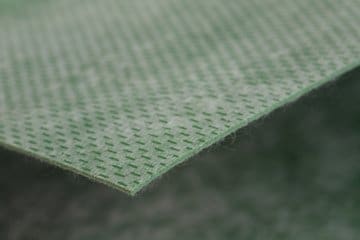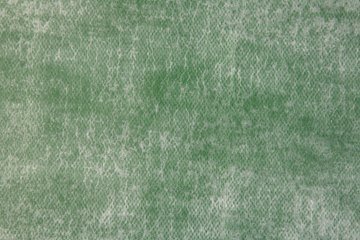You’ve picked out the perfect vinyl floor and can’t wait to see how it looks. But before you get started with the installation, you have another decision to make, and it’s just as important as the flooring itself: What underlayment will you need?
In this article you will get a comprehensive overview of underlayment and subfloors for vinyl flooring. You will also know enough to avoid having to take out an insurance claim against an installer for an improper installation.
Watch the video summary or read on to learn all about underlayment, or go directly to our recommendation. Either way, you will know the quickest solution for the best underlayment for vinyl flooring.
What is Underlayment?
Underlayment is the layer of material that’s installed between the subfloor and the flooring. It works as a part of your overall flooring system, which consists of the joists, subfloor, underlayment, and the flooring surface.
The purpose of underlayment is to provide necessary moisture control, sound deadening, warmth, and to minimize deflection, which is the bend or sag in the floor caused by loading.
Most modern vinyl flooring, such as Happy Feet, comes with an attached underlayment or pad, often with a moisture barrier built-in – unless the pad is cork.
If the product you choose doesn’t have an attached underlayment, you can almost always install directly over the subfloor without one. But this may result in an unsatisfactory experience. If you want to maximize softness, warmth, moisture protection, and noise reduction, then underlayment is key.
Underlayment Thickness
You may hear that a good rule of thumb is to install vinyl over 1-1.5mm underlayment or cork. But making definitive statements about max thickness without considering the density and make-up of the material can cause problems. Always speak to a flooring expert if you have a particular question about your flooring and its compatibility with underlayment.
What About a Double Underlayment?
More is not always better, and with underlayment, too much can compromise the integrity of your floor’s locking system. Adding additional underlayment under vinyl with an attached pad can create too much cushioning, which causes the floor to come apart through use over time. That’s why double underlayment (more than one underlayment) is generally not recommended. Doing so can also void the warranty.
However, there are instances where you can install additional underlayment. For example, if your floor has an attached cork pad, you may want to also install a very thin moisture barrier. If you follow the manufacturer’s instructions, you will be fine. Following the manufacturer’s instructions exactly will also prevent voiding the warranty.
Underlayment Benefits
Underlayment can provide a confluence of benefits: noise reduction, cushioning, warmth, and moisture/water protection. When correctly installed, underlayment can minimize deflection, especially in the seams where the planks meet, to prevent stress to the locking mechanism.
Sound Reduction & Absorption
Underlayment can help you reduce noise, but it won’t completely mute the sound of footfalls or clomping feet.
When it comes to sound insulation for flooring, there are two main ratings to consider – IIC and STC. Impact Insulation Class (IIC) measures the ability of a floor to block impact noise, such as footsteps or a dropped book. Sound Transmission Class (STC) measures the ability to reduce the sound of airborne noise, such as voices and music from a sound system.
The higher the number of these ratings, the better.
The best underlayment for noise reduction will reduce both impact noise and airborne sound. If reducing sound is important to you, then you will want to pay close attention to a product’s IIC and STC ratings.
Cushioning & Deflection
In addition to sound absorption, underlayment can also make a noticeable difference in how your floor feels.
For example, a glue-down vinyl plank floor on concrete will feel harder and less comfortable than a floating floor with foam underlayment.
Just remember that too much cushioning can cause the joints to come apart and the floor to unlock.
Moisture Barrier
Even though vinyl flooring is waterproof, your subfloor isn’t. That’s why an underlayment acting as a moisture barrier is essential.
Warmth
Underlayment has thermal properties that can increase the warmth of the floor. Select an underlayment with a thermal R rating to help keep your floors warm.
Know that underlayment can only do so much to keep your floors warm, especially on concrete floors in your basement.
Vinyl flooring has a reputation for being cold, so if that’s a dealbreaker, then you may want to consider an alternative like laminate, which is warmer and feels softer. Or else you can look into radiant heating systems.
The Different Types of Underlayment
The most used types of underlayment for vinyl are cork, foam, felt, rubber, plywood, and OSB.
Cork
When it comes to reducing noise in your home, cork is an excellent option. Cork is dense and can help hide imperfections in the subfloor.
If your vinyl flooring already has an underlayment, you can add compressed cork to further enhance sound insulation. However, cork is not a moisture barrier. Cork will retain moisture, which can lead to mold formation, especially if it isn’t properly installed.
Installing over a concrete slab with cork underlayment? Always lay down a moisture barrier before installing the floor.
Foam
Foam is a cost-effective underlayment that provides some cushioning and limited insulation with average sound dampening. The thicker the foam, the better the results. You just need to be sure to install it correctly.
Foam underlayment is not a moisture barrier and can act as a water trap, leading to mold and must.
Felt
Felt is a popular underlayment choice, offering better sound control than foam. With foam, you also have the option to choose an attached vapor barrier, and it provides better insulation than foam and cork.
Particle Board
Particle board is an inexpensive way to lay a level base under vinyl flooring; however, it’s ineffective against moisture, a pain to install, and difficult to remove.
Rubber
Rubber underlayment is an effective underlayment, great for absorbing sound, adding warmth, and protecting against water damage.
Plywood and OSB
Plywood and OSB provides a nice and level base for LVP and LVT floors but doesn’t offer warmth or cushioning. OSB offers better durability than plywood.
Underlayment & the Subfloor
The subfloor is the foundation of any flooring installation, and its importance cannot be overstated. A smooth and effective installation of vinyl flooring requires a solid and stable subfloor that provides a strong base for the new flooring material.
No underlayment or vinyl flooring product can make up for a poor subfloor.
Installing vinyl on a rough, unclean, or damaged subfloor is like trying to build a cabin on unstable ground – it just won’t stand the test of time.
When the floor isn’t as level as possible, the floor can drop in the low spots and cause damage to the planks. But no subfloor is going to be perfectly level. Your subfloor can have a pitch to it, but you need to avoid peaks and valleys.
Ensuring that the subfloor is smooth, clean, mostly level, and free of damage (cracks) is necessary for a flawless installation. A solid and level subfloor eliminates many problems: loud creaking, dips, high spots, soft spots, bumps, and uneven lumpiness.
This is why it pays to take care to properly prepare your subfloor. You can think of it as an investment in the longevity and performance of your vinyl flooring.
What About Leveling Agents?
You can use leveling agents, but they should be your last option.
Concrete
If your vinyl flooring has a pad attached, you can install it directly over the concrete subfloor. If you don’t have a pad attached then consider using a 1mm or less foam pad to help the floor float properly.
Before you install your underlayment and flooring, repair any hairline cracks in your concrete subfloor and make sure you level it out.
Over a concrete subfloor, you need a Class I moisture barrier to prevent moisture from moving up and sitting beneath your flooring.
If you install over concrete without any underlayment, there is a good chance that small amounts of moisture will be absorbed into the concrete because it’s porous.
Wood
¼” plywood works well as a subfloor for vinyl, and you can install vinyl directly over wood. Over a wood subfloor, you need a Class II moisture retardant.
If your wood subfloor is old and worn with holes, gaps, and cracks, you can use a liquid leveling agent to create a smooth surface.
Existing floors
If you have existing linoleum, wood, sheet vinyl, or tile that are level and in good condition, congratulations, you have a great foundation for installing vinyl. Never install over floating laminate or LVP/LVT.
You will save yourself time cleaning up a mess by installing over the existing floor instead of removing it.
What if Your Subfloors Vary in Height?
If you have rooms with subfloors of different heights, it’s probably for a good reason. You will want to keep in mind the floor’s thickness and come up with a plan to manage the height difference.
With a 2mm – 1” difference, you can hire a professional to even your subfloor.
Looking for the easiest and least expensive solution? Use transition molding from one floor to the other. Reducer molding transitions height differences smoothly.
If you have another type of flooring in your home that’s a particular height, you can choose the flooring thickness and underlayment thickness to be on par with that flooring.
For example, if you have tile installed that’s 6mm thick, you can install 5mm thick vinyl flooring with a 1mm underlayment to create a seamless transition from one floor to the next.
Underlayment for Vinyl Pro Tips
- Do not install vinyl over a heating pad; heating pads are reserved for flooring that adheres to the subfloor, such as ceramic tile.
- Avoid electric radiant heat because it can cause your floor’s locking joints to fail.
- Do not install vinyl over carpet underlayment because it will be too soft, and over time the planks will come apart.
- Do not Install over another floating floor, such as laminate, because laminate floors can buckle and shift.
- Do not put underlayment on only 1/2 of the floor. Use it on the entire floor or don’t use it at all.
- If you have an older home with asbestos present, use asbestos encapsulant to seal it and install ¼” plywood over top before putting down underlayment.
- You don’t need underlayment for sheet vinyl, but it can help to smooth out the imperfections.
The Best Underlayment for Vinyl Flooring
Panel Town’s expert on underlayment, Brandon Bembenic, recommends Whisper Step as the best underlayment for all flooring installs, especially vinyl:
“The best underlayment to use for vinyl flooring is Whisper Step. The reason we sell so much of it and recommend it is that it is basically universal – you can put it under floating floors, nail-down floors, or glue-down floors; vinyl, laminate, engineered wood or solid wood. It provides Class II moisture control and sound deadening and minimizes squeaks and creaks.”
If you don’t want to be bogged down by the details of what you can and can’t use but desire a quick solution that also offers the best results possible, go with Whisper Step.
Whisper Step Over a Wood Subfloor
Whisper Step serves as a Class II moisture retardant, so it’s all you need over a wood subfloor.
Whisper Step Over a Concrete Subfloor
You will need a Class I moisture barrier (6mil plastic) in addition to Whisper Step over a concrete subfloor.
Summary
Choosing underlayment for vinyl flooring can be a confusing process that leaves you with more questions than answers. You have to consider many variables, such as your budget, the underlayment, your vinyl floor, and subfloor type.
Installing the wrong underlayment can compromise the integrity of the floor and leave you with problems to fix. It can also void the warranty. That’s why it’s important to make sure your subfloor is as level as realistically possible (and smooth) and that you find the right underlayment.
Underlayment isn’t always required to install vinyl flooring, but it can make all the difference. Our customers have had great success with Whisper Step, and we continue to recommend it as our preferred underlayment product for vinyl flooring.











